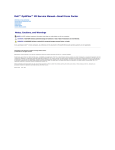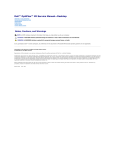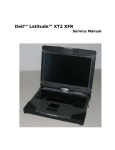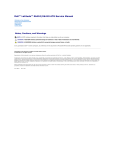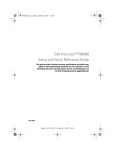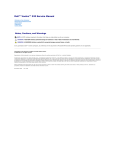Download Latitude E5400 Service Manual (With discrete video)
Transcript
Dell™ Latitude™ E5400 Discrete Service Manual Working on Your Computer Adding and Replacing Parts Specifications Diagnostics System Setup Notes, Cautions, and Warnings NOTE: A NOTE indicates important information that helps you make better use of your computer. CAUTION: A CAUTION indicates potential damage to hardware or loss of data if instructions are not followed. WARNING: A WARNING indicates a potential for property damage, personal injury, or death. If you purchased a Dell™ n Series computer, any references in this document to Microsoft® Windows® operating systems are not applicable. Information in this document is subject to change without notice. © 2009 Dell Inc. All rights reserved. Reproduction of this material in any manner whatsoever without the written permission of Dell Inc. is strictly forbidden. Trademarks used in this text: Dell, the DELL logo, Latitude, TravelLite, Wi-Fi Catcher, and ExpressCharge, are trademarks of Dell Inc.; Intel, Pentium, Celeron, Intel Atom, and Core are either trademarks or registered trademarks of Intel Corporation; Bluetooth is a registered trademark owned by Bluetooth SIG, Inc. and is used by Dell under license; TouchStrip is a trademark of Zvetco Biometrics, LLC; Blu-ray Disc is a trademark of the Blu-ray Disc Association; Microsoft, Windows, Windows Server, MS-DOS, Aero, Windows Vista, and the Windows Vista start button are either trademarks or registered trademarks of Microsoft Corporation in the United States and/or other countries; Adobe, the Adobe logo, and Adobe Flash Player are trademarks of Adobe Systems Incorporated. Other trademarks and trade names may be used in this document to refer to either the entities claiming the marks and names or their products. Dell Inc. disclaims any proprietary interest in trademarks and trade names other than its own. July 2009 Rev. A00 Back to Contents Page System Setup Dell™ Latitude™ E5400 Discrete Service Manual <F12> Menu Entering System Setup Boot Menu Drive BIOS Quicktest Navigation Keystrokes System Setup Menu Options Your computer offers the following BIOS and System Setup options: l l l Access System Setup by pressing <F2> Bring up a one-time boot menu by pressing <F12> Start the Pre-boot System Assessment by pressing <Fn> and the power button <F12> Menu Press <F12> when the Dell™ logo appears to initiate a one-time boot menu with a list of the valid boot devices for the computer. Diagnostics and Enter Setup options are also included in this menu. The devices listed on the boot menu depend on the bootable devices installed in the computer. This menu is useful when you are attempting to boot to a particular device or to bring up the diagnostics for the computer. Making changes in the boot menu does not make any changes to the boot order stored in the BIOS. Entering System Setup Press <F2> to enter System Setup and make changes to user-definable settings. If you have trouble entering System Setup using this key, press <F2> when the keyboard lights first flash. Boot Menu Your computer features an enhanced one-time boot menu: l l l Easier access—Access the menu by pressing <F12> during system boot User prompting—The missing keystroke is now displayed on the BIOS splash screen Added diagnostics options—The boot menu now includes two new options: IDE Drive Diagnostics (90/90 hard drive diagnostics) and Boot to the Utility Partition Drive BIOS Quicktest The Drive BIOS Quicktest allows you to test the physical functionality of the hard drive without having to locate and download files from support.dell.com or make bootable floppies or CDs. Select IDE Drive Diagnostics from the boot menu to initiate the test. Navigation Keystrokes Use the following keystrokes to navigate the System Setup screens. Navigation Keystrokes Action Keystroke Expand and collapse field <Enter>, left- or right-arrow key, or +/– Expand or collapse all fields <> Exit BIOS <Esc>—Remain in Setup, Save/Exit, Discard/Exit Change a setting Left or right-arrow key Select field to change <Enter> Cancel modification <Esc> Reset defaults <Alt><F> or Load Defaults menu option System Setup Menu Options The following tables describe the menu options for the System Setup BIOS. General Option Description This section lists the primary hardware features of your computer. There are no configurable options in this section. l System Information ¡ BIOS Version ¡ Service Tag ¡ Asset Tag ¡ Ownership Tag l l System Information l Battery Information Memory Information ¡ Memory Installed ¡ Memory Available ¡ Memory Speed ¡ Memory Channel Mode ¡ Memory Technology ¡ DIMM A Size ¡ DIMM B Size Processor Information ¡ Processor Type ¡ Core Count ¡ Processor ID ¡ Current Clock Speed ¡ Minimum Clock Speed ¡ Maximum Clock Speed Device Information ¡ Primary Hard Drive ¡ Modular Bay Device ¡ System eSATA Device ¡ Dock eSATA Device ¡ Video Controller ¡ Video BIOS Version ¡ Video Memory ¡ Panel Type ¡ Native Resolution ¡ Audio Controller ¡ Modem Controller ¡ Wi-Fi Device ¡ Cellular Device ¡ Bluetooth Device Indicates the primary battery and the media bay battery status. Also displays the type of AC adapter connected to the computer. The computer attempts to boot from the sequence of devices specified in this list: l l l Boot Sequence l l l Diskette drive USB Storage Device CD/DVD/CD-RW Drive. Internal HDD Cardbus NIC Onboard NIC This list specifies the order that the BIOS searches devices when trying to find an operating system to boot. To change the boot order, select the device to be changed in the list then click the up/down arrows or use the keyboard PgUp/PgDn keys to change the boot order of the device. The boot devices can also be de-selected from the list using the check boxes. Date/Time Displays current date and time settings. System Configuration Option NOTE: Description The System Configuration group contains options an settings relater to integrated system devices. (Depending on your computer and installed devices, the items listed in this section may or may not appear.) Enables or disables the onboard LAN controller. Integrated NIC Default setting: Enabled w/PXE System Management Controls system management mechanism. The setting options are Disabled, Alert Only, and ASF 2.0. Default setting: Disabled This field determines how the parallel port on the docking station operates. Parallel Port Default setting: ECP This field determines how the integrated serial port operates. The settings are Disabled, COM1, COM2, COM3 and COM4. Serial Port Default setting: COM1 This option configures the operating mode of the internal SATA hard drive controller. The settings are Disabled, ATA, and AHCI. SATA Operation Default setting: AHCI Use the check boxes to enable/disable the following devices: l l Miscellaneous Devices l l l l Internal Modem Module Bay Media Card, PC Card and 1394 External USB Port Microphone eSATA Ports Default setting: All enabled. USB PowerShare This option configures the USB PowerShare feature behavior. Use the check box to enable / disable the feature (default state is disabled). The settings are 0%, 3%, 10%, 25%, 50%, and 75%. Video Option LCD Brightness Description This option (represented by a slider bar for On Battery and On AC) sets the panel brightness when the ambient light sensor is off. Security Option Description This field lets you set, change, or delete the administrator (admin) password (sometimes called the "setup" password). The admin password enables several security features when set including: l l l Admin Password l Restricts changes to the settings in Setup Restricts the boot devices listed in the <F12> Boot Menu to those enabled in the "Boot Sequence" field. Prohibits changes to the owner and asset tags. Substitutes for the system password if the system prompts for a password during power on. Successful changes to this password take effect immediately. If you delete the admin password, the system password is also deleted. Also, the admin password can be used to delete the HDD password. For this reason, you cannot set an admin password if a system password or HDD is already set. The admin password must be set first if used in conjunction with a system and/or HDD password. System Password This field lets you set, change, or delete the system password (previously called the "Primary" password). This field lets you set, change, or delete the password on the system's internal hard disk drive (HDD). Successful changes take place Internal HDD PW immediately and require a system restart. The HDD password travels with the hard drive, so the HDD is protected even when installed in another system. Password Bypass This option lets you bypass the system and internal HDD password prompts during a system restart or when resuming from a standby state. Settings are Disabled, Reboot Bypass, Resume Bypass, and Reboot & Resume Bypass. The system will always prompt for the set system and internal HDD password when powered on from an off state (cold boot). Password Change This option lets you determine whether changes to the System and HDD passwords are permitted when an Admin password is set. Use the check box to allow or disallow changes. This option lets you control whether the Trusted Platform Module (TPM) in the system is enabled and visible to the operating system. When disabled (check box is empty), the BIOS will not turn on the TPM during POST. The TPM will be non-functional and invisible to the operating system. When enabled (check box filled) the BIOS will turn the TPM on during POST so the it can be used by the operating system. Disabling this option does not change any settings you may have made to the TPM, nor does it delete or change any information or keys you may have stored there. It simply turns off the TPM so that it cannot be used. When you re-enable the TPM, it will function exactly as it did before it was disabled. TPM Security Once TPM is enabled (check box filled), the available settings are: Deactivate, Activate, and Clear. With the TPM in Deactivate mode it will not execute any commands that use the resources of the TPM, nor will it allow any access to stored owner information. The Clear setting allows the owner information stored in the TPM to be cleared. Use this to restore the TPM to its default state if you lose or forget the owner authentication data. Computrace® This field lets you activate or disable the BIOS module interface of the optional Computrace software. The settings are Deactivate, Disable, and Activate. The Activate and Disable options will permanently activate or disable the feature and no further changes will be allowed. This field enables or disables the Execute Disable mode of the processor. Use the check box to enable / disable this feature. CPU XD Support Default setting: Enabled This option lets you determine whether changes to the setup option are permitted when an administrator password is set. If disabled Non-Admin Setup the setup option is locked by the admin password. It cannot be modified unless setup is unlocked. Use the check boxes to allow / deny Changes access to the Wi-Fi Catcher Changes and / or Wireless Switch Changes within the system setup. Performance Option Description Multi Core Support Use the check box to enable / disable multi core support for the CPU. HDD Acoustic Mode This option allows you to optimize your HDD's performance and acoustic noise level based on your personal preferences. Settings are Bypass, Quiet, and Performance. Intel® SpeedStep Use the check box to enable / disable mode for the CPU. Power Management Option Wake on AC Auto On Time Description Use the check box to enable / disable the computer to power up from the off or hibernation state when an AC adapter is inserted. This field sets the of days, if any, when you would like the system to turn on automatically. The settings are Disabled, Everyday, or Weekdays. Default setting: Off Use the check box to enable / disable the ability for USB devices to wake the system from Standby. USB Wake Support This feature is only functional when the AC power adapter is connected. If the AC power adapter is removed during Standby, the BIOS will remove power from all of the USB ports to conserve battery power. This field allows the computer to power up from the off state when triggered by a special LAN signal or from Hibernate state when triggered by a special wireless LAN signal. Wake-up from the Standby state is unaffected by this setting and must be enabled in the operating system. Wake on LAN/WLAN Disabled — Do not allow the system to power on when it receives a wake-up signal from the LAN or wireless LAN. LAN Only — Allow the system to be powered on by special LAN signals. WLAN Only — Allow the system to be powered on by special WLAN signals. LAN or WLAN — Allow the system to be powered on by special LAN or wireless LAN signals. l l l l The factory default setting is Off. This field lets you select fast the battery will charge. Standard = The battery will charge over a longer period of time. ExpressCharge = Dell fast charging technology (not available for all batteries). ExpressCharge Default setting: ExpressCharge Charger Behavior This field lets you enable / disable the battery charger. If disabled, the battery will not lose power when the system is connected to an AC adapter but it will not charge either. Default setting: Charger Enabled POST Behavior Option Description Adapter Warnings Use the check box to enable / disable the BIOS warning messages when you use certain power adapters. The BIOS displays these messages if you attempt to use a power adapter that has too little capacity for your configuration. The factory default setting is Enabled. This option lets you choose one of two methods to enable the keypad that is embedded in the internal keyboard. l l Keypad (Embedded) Fn Key Only — The keypad is only enabled when you hold down the <Fn> key. By Num Lk — The keypad is enabled when (1) the Num Lock LED is on and (2) no external keyboard is attached. Note that the system might not notice immediately when an external keyboard is detached. When Setup is running, this field has no effect—Setup works in the FN Key Only mode. The factory default setting is Fn Key Only. This option defines how the system handles mouse and touch pad input. l Mouse/Touchpad l l Serial Mouse — Use a serial mouse and disable the internal touch pad. PS/2 Mouse — Disable the integrated touch pad when an external PS/2 mouse is present. Touchpad-PS/2 — Leave the integrated touch pad enabled when an external PS/2 mouse is present. The factory default setting is Touchpad-PS/2. Use the check box to enable / disable the Num Lock LED when the system boots. Numlock LED The factory default setting is Enabled. This option defines how the BIOS, in the absence of a USB-aware operating system, handles USB devices. USB emulation is always enabled during POST. Use the check box to enable / disable this feature. USB Emulation The factory default setting is Enabled. This field lets you use the <Scroll Lock> key on an external PS/2 keyboard the same way you use the <Fn> key on the computer's internal keyboard. Use the check box to enable / disable this feature. Fn Key Emulation USB keyboards cannot emulate the <Fn> key if you are running an ACPI operating system such as Microsoft® Windows® XP. USB keyboards will only emulate the <Fn> key in non-ACPI mode (e.g., when you are running a DOS). The factory default setting is Enabled. This field can speed up the boot process by bypassing some compatibility steps. Fast Boot l l l Minimal — Boot quickly unless the BIOS has been updated, memory changed, or the previous POST did not complete. Thorough — Do not skip any steps in the boot process. Auto — Allow the operating system to control this setting (this works only when the operating system supports Simple Boot Flag). The factory default setting is Minimal. Virtualization Support Option Virtualization Description This field specifies whether a Virtual Machine Monitor (VMM) can utilize the additional hardware capabilities provided by Intel® Virtualization Technology. Use the check box to enable/disable this feature. The factory default setting is Disabled. VT for Direct I/O This option specifies whether a Virtual Machine Monitor (VMM) can utilize the additional hardware capabilities provided by Intel Virtualization Technology for Direct I/O. Use the check box to enable/disable this feature. The factory default setting is Disabled. Trusted Execution This option specifies whether a Measured Virtual Machine Monitor (MVMM) can utilize the additional hardware capabilities provided by Intel Trusted Execution Technology. The TPM, Virtualization Technology, and Virtualization Technology for Direct I/O must be enabled to use this feature. Use the check box to enable/disable this feature. The factory default setting is Disabled. Wireless Option Description This field lets you enable or disable the Wi-Fi Catcher™ feature. If this setting is set to Disabled, the Wi-Fi Catcher request position on the wireless switch will be ignored. If this setting is set to Enabled, the Wi-Fi Catcher switch is enabled and will use the previously configured options. If Reset to Basic Mode is selected the Wi-Fi Catcher options will be written such that the Wi-Fi Catcher will search for any available network and the Wi-Fi catcher will be set to Enabled. The QuickSet application should be used to configure and view the Wi-Fi catcher advanced options. Wi-Fi Catcher The factory default setting is Enabled. Wireless Switch Wireless Devices Use the check boxes to determine which wireless devices will be controlled by the wireless switch. The available options are WWAN, WLAN, and Bluetooth®. Use the check boxes to enable/disable the various wireless devices. The available options are Internal WWAN, Internal WLAN, and Internal Bluetooth. Maintenance Option Service Tag Asset Tag Description This field displays your system's Service Tag. If for some reason the Service Tag was not already set, you would be able to use this field to set it. If a Service Tag has not been set for this system, the computer will automatically bring up this screen when users enter the BIOS. You will be prompted to enter the Service Tag. This field allows you to create a system Asset Tag. The field can only be updated if the Asset Tag is not already set. System Logs Option Description BIOS Events This field allows you to view and clear BIOS POST events. It includes the date and time of the event as well as the LED code. DellDiag Events This field allows you to view the diagnostic results from DellDiags and PSA. It includes the time and date, the diagnostic and version which was run and the resulting code. Thermal Events This field allows you to view and clear thermal events. It includes the date and time as well as the name of the event. Power Events This field allows you to view and clear power events. It includes the date and time of the event as well as the power state and reason. Back to Contents Page Back to Contents Page Diagnostics Dell™ Latitude™ E5400 Discrete Service Manual Device Status Lights Battery Status Lights Battery Charge and Health Keyboard Status Lights LED Error Codes Device Status Lights Turns on when you turn on the computer and blinks when the computer is in a power management mode. Turns on when the computer reads or writes data. Turns on steadily or blinks to indicate battery charge status. Turns on when wireless networking is enabled. Turns on when a card with Bluetooth® wireless technology is enabled. To turn off only the Bluetooth wireless technology function, right-click the icon in the system tray and select Disable Bluetooth Radio. Battery Status Lights If the computer is connected to an electrical outlet, the battery light operates as follows: l l l l l Alternately blinking amber light and blue light — An unauthenticated or unsupported, non-Dell AC adapter is attached to your laptop. Alternately blinking amber light with steady blue light — Temporary battery failure with AC adapter present. Constantly blinking amber light — Fatal battery failure with AC adapter present. Light off — Battery in full charge mode with AC adapter present. Blue light on — Battery in charge mode with AC adapter present. Battery Charge and Health To check the battery charge, press and release the status button on the battery charge gauge to illuminate the charge-level lights. Each light represents approximately 20 percent of the total battery charge. For example, if four lights are on, the battery has 80 percent of its charge remaining. If no lights appear, the battery has no charge. To check battery health using the charge gauge, press and hold the status button on the battery charge gauge for at least 3 seconds. If no lights appear, the battery is in good condition and more than 80 percent of its original charge capacity remains. Each light represents incremental degradation. If five lights appear, less than 60 percent of the charge capacity remains, and you should consider replacing the battery. Keyboard Status Lights The green lights located above the keyboard indicate the following: Turns on when the numeric keypad is enabled. Turns on when the Caps Lock function is enabled. Turns on when the Scroll Lock function is enabled. LED Error Codes The following table shows the possible LED codes that may display in a no-POST situation. Appearance Description ON-FLASH-FLASH Next Step 1. 2. No SODIMMs are installed 4. Install supported memory modules. If memory is already present, reseat the module(s) one at time in each slot. Try known good memory from another computer or replace the memory. Replace the system board. 1. 2. 3. Reseat the processor. Replace the system board. Replace the processor. 3. FLASH-ON-ON System board error FLASH-ON-FLASH LCD panel error OFF-FLASH-OFF 1. 2. 3. Reseat the LCD cable. Replace the LCD panel. Replace the video card/system board. 1. 2. Install compatible memory modules. If two modules are installed remove one and test. Try the other module in the same slot and test. Test the other slot with both modules. Replace the memory. Replace the system board. Memory compatibility error 3. 4. ON-FLASH-ON 1. 2. Memory is detected but has errors 3. 4. Reseat the memory. If two modules are installed remove one and test. Try the other module in the same slot and test. Test the other slot with both modules. Replace the memory. Replace the system board. 1. 2. 3. Reseat the modem. Replace the modem. Replace the system board. 1. Replace the system board. 1. 2. 3. Reseat the device. Replace the device. Replace the system board. 1. 2. 3. 4. Reseat the hard drive and optical drive. Test the computer with just the hard drive and just the optical drive. Replace the device that is causing the failure. Replace the system board. 1. Replace the system board. OFF-FLASH-FLASH Modem error FLASH-FLASH-FLASH System board error FLASH-FLASH-OFF Option ROM error OFF-ON-OFF Storage device error FLASH-FLASH-ON Video card error Back to Contents Page Back to Contents Page Adding and Replacing Parts Dell™ Latitude™ E5400 Discrete Service Manual Battery Access Panel Coin-Cell Battery Hard Drive Hard Drive Assembly Memory WLAN Card Modem WWAN Card Heat Sink Processor Hinge Cover Keyboard Optical Drive Display Assembly Display Bezel Display Inverter Display Camera Display Panel Display Cable Palm Rest System Board I/O Board Back to Contents Page Back to Contents Page Specifications Dell™ Latitude™ E5400 Discrete Service Manual Processor System Information 3-in-1 Memory Card Reader Ports and Connectors Memory Video Communications Display Audio Touch Pad Keyboard AC Adapter Battery Environmental Physical NOTE: Offerings may vary by region. For more information regarding the configuration of your computer, click Start (or Start in Windows® XP)® Help and Support, and then select the option to view information about your computer. Processor Processor type Intel® Core™ 2 Duo processors Intel Celeron® processor (Socket P) Bus speed maximum, 1066 MHz for Intel Core 2 Duo L1 cache 32 KB L2 cache 1 MB System Information System chipset Mobile Intel GE45 Express chipset Data bus width 64 bits DRAM bus width Dual-channel (2) 64 bit buses Processor address bus width 32 bits Flash EPROM 16 MB PCI bus 32 bits 3-in-1 Memory Card Reader Cardbus controller Ricoh R5C847 Connector 3-in-1 combo card connector Cards supported SecureDigital (SD), SDIO, MultiMediaCard (MMC) Memory Memory module connectors two DIMM sockets Memory module capacities 512 MB, 1, 2, 3, or 4 GB capable Memory type DDR II 667 MHz and 800 MHz SDRAM Minimum memory 512 MB Maximum memory 8 GB Ports and Connectors PC Card Type I/II PC Card connector Audio microphone connector, and stereo headphone/speakers connector IEEE 1394 4-pin connector Mini-Card One full Mini-Card and one half Mini-Card slot Modem Optional RJ-11 connector Network adapter RJ-45 connector Video S-video (supports S/PDIF adapter), VGA USB four USB connectors E-family docking 144-pin docking connector Communications Modem internal (optional) Network adapter 10/100/1000 Ethernet LAN on system board Wireless WLAN and WPAN Mini-Cards Mobile Broadband Mini-Card GPS supported by Mobile Broadband Mini-Card Video Video type Intel integrated UMA graphics Video controller NVIDIA NB9M Video memory up to 512 MB (256 MB onboard, up to 256 MB shared from system memory) LCD interface LVDS TV support S-video (S/PDIF) connector Audio Audio type high definition audio Audio controller IDT® 92HD71B Stereo conversion 24-bit (stereo digital-to-analog) 24-bit (stereo analog-to-digital) Interfaces: Internal high definition audio External microphone-in connector, stereo headphones/speakers mini-connector Speakers two 4-ohm speakers Internal speaker amplifier 1-Watt channel into 4 ohms Internal microphone single analog microphone Volume controls volume control buttons and program menus Display Type (active-matrix TFT) WSVGA or WSGA touch screen Dimensions VESA standard on all models Operating angle 0° (closed) to 160° Viewing angles: WXGA horizontal 40 / 40° WXGA vertical 15 / 30° WXGA+ horizontal 40 / 40° WXGA+ vertical 15 / 30° Pixel pitch: WXGA 0.2373 WXGA+ 0.2109 Keyboard Number of keys 83 (all countries except Denmark, United Kingdom, Brazil, and Japan); 84 (Denmark and United Kingdom); 85 (Brazil); 87 (Japan) Layout QWERTY/AZERTY/Kanji Size full-sized (19 mm key pitch) Touch Pad X/Y position resolution (graphics table mode) 240 CPI Size: Width 65.7 mm Height 38.2 mm Battery Type 4, 6, or 9-cell "smart" lithium ion (6-cell is default) Dimensions: Depth 4- or 6-cell lithium-ion battery 54 mm (1.12 inches) 9-cell lithium-ion battery 76 mm (1.99 inches) Height 4- or 6-cell lithium-ion battery 19.8 mm (0.77 inches) 9-cell lithium-ion battery 21.1 mm (0.83 inches) Width 4- or 6-cell lithium-ion battery 206 mm (7.11 inches) 9-cell lithium-ion battery 224 mm (7.81 inches) Weight 4- or 6-cell lithium-ion battery 326 g (.72 pounds) 9-cell lithium-ion battery 487 g (1.07 pounds) Voltage 4-cell lithium-ion battery 14.8 VDC 6- or 9-cell lithium-ion battery 11.1 VDC Charge time (approximate) Dell™ ExpressCharge™ mode 2 hours to fully charge Normal charge mode 4 hours to fully charge Operating time varies depending on operating conditions and can be significantly reduced under certain power-intensive conditions Recharge limit 300 discharge/charge cycles Temperature range Operating 0° to 35°C (32° to 95°F) Storage -40° to 65°C (-40° to 149°F) Coin-cell battery 4-year life AC Adapter Type 65 W auto-air adapter (optional) 90 W E-series Input voltage 100-240 VAC Input current (maximum) 1.5 A Input frequency 50-60 Hz Output current 65 W 3.34 A (maximum at 4-second pulse) 4.62 A (continuous) 90 W 5.62 A (maximum at 4-second pulse) 4.62 A (continuous) Output power 65 W or 90 W Rated output voltage 19.5 VDC Dimensions 65 W Height 16 mm (0.63 inches) Width 66 mm (2.6 inches) Depth 127 mm (5.0 inches) Weight (with cables) 0.29 kg (0.64 lb) 90 W Height 16 mm (0.63 inch) Width 70 mm (2.76 inches) Depth 147 mm (5.8 inches) Weight (with cables) 0.345 kg (0.76 lb) Temperature range Operating 0° to 40° C (32° to 104° F) Storage –40° to 70° C (–40° to 158° F) Physical Height 338 mm (13.31 inches) Width 240 mm (9.45 inches) Depth 37.0 mm (1.46 inches) Weight 2.54 kg (5.6 lb) 6-cell battery, and DVD Environmental Temperature range: Operating 0° to 35°C (32° to 95°F) Storage –40° to 65°C (–40° to 149°F) Relative humidity (maximum): Operating 10% to 90% (non-condensing) Storage 5% to 95% (non-condensing) Maximum vibration (using a random-vibration spectrum that simulates user environment): Operating 0.66 GRMS Storage 1.3 GRMS Maximum shock (measured with hard drive in head-parked position and a 2-ms half-sine pulse): Operating 140 G Storage 163 G Altitude Operating –15.2 to 3048 m (–50 to 10,000 ft) Storage –15.2 to 10,668 m (–50 to 35,000 ft) Airborne contaminant level G2 or lower as defined by ANSI/ISA-S71.04-1985 Back to Contents Page Back to Contents Page Battery Dell™ Latitude™ E5400 Discrete Service Manual WARNING: Before working inside your computer, read the safety information that shipped with your computer. For additional safety best practices information, see the Regulatory Compliance Homepage at www.dell.com/regulatory_compliance. Removing the Battery NOTE: You may need to install Adobe Flash Player from Adobe.com in order to view the illustrations below. 1. 2. Follow the procedures in Before Working Inside Your Computer. Slide the battery release latch into the unlocked position. 3. Remove the battery from the computer. Back to Contents Page Back to Contents Page Access Panel Dell™ Latitude™ E5400 Discrete Service Manual WARNING: Before working inside your computer, read the safety information that shipped with your computer. For additional safety best practices information, see the Regulatory Compliance Homepage at www.dell.com/regulatory_compliance. Removing the Access Panel NOTE: You may need to install Adobe Flash Player from Adobe.com in order to view the illustrations below. 1. 2. 3. Follow the procedures in Before Working Inside Your Computer. Remove the battery from the computer. Loosen the four captive screws that secure the access panel to the computer. 4. Remove the access panel from the computer. Back to Contents Page Back to Contents Page Coin-Cell Battery Dell™ Latitude™ E5400 Discrete Service Manual WARNING: Before working inside your computer, read the safety information that shipped with your computer. For additional safety best practices information, see the Regulatory Compliance Homepage at www.dell.com/regulatory_compliance. Removing the Coin-Cell Battery NOTE: You may need to install Adobe Flash Player from Adobe.com in order to view the illustrations below. 1. 2. 3. 4. Follow the procedures in Before Working Inside Your Computer. Remove the battery from the computer. Remove the access panel from the computer. Disconnect the coin-cell battery cable from the system board. 5. Release the coin-cell battery from the retention clips. 1. Back to Contents Page Back to Contents Page Hard Drive Dell™ Latitude™ E5400 Discrete Service Manual WARNING: Before working inside your computer, read the safety information that shipped with your computer. For additional safety best practices information, see the Regulatory Compliance Homepage at www.dell.com/regulatory_compliance. Removing the Hard Drive NOTE: You may need to install Adobe Flash Player from Adobe.com in order to view the illustrations below. 1. 2. 3. 4. Follow the procedures in Before Working Inside Your Computer. Remove the battery from the computer. Remove the access panel from the computer. Remove the four screws that secure the hard drive to the computer. 5. Using the pull tab, lift the hard drive from the computer. Back to Contents Page Back to Contents Page Memory Dell™ Latitude™ E5400 Discrete Service Manual WARNING: Before working inside your computer, read the safety information that shipped with your computer. For additional safety best practices information, see the Regulatory Compliance Homepage at www.dell.com/regulatory_compliance. Removing Memory Modules NOTE: You may need to install Adobe Flash Player from Adobe.com in order to view the illustrations below. 1. 2. 3. 4. Follow the procedures in Before Working Inside Your Computer. Remove the battery from the computer. Remove the access panel from the computer. Gently pry the retention clips away from the first memory module. 5. Remove the first memory module from the computer. 6. Gently pry the retention clips away from the second memory module. 7. Remove the second memory module from the computer. Back to Contents Page Back to Contents Page Wireless Local Area Network (WLAN) Card Dell™ Latitude™ E5400 Discrete Service Manual WARNING: Before working inside your computer, read the safety information that shipped with your computer. For additional safety best practices information, see the Regulatory Compliance Homepage at www.dell.com/regulatory_compliance. Removing the WLAN Card NOTE: You may need to install Adobe Flash Player from Adobe.com in order to view the illustrations below. 1. 2. 3. 4. Follow the procedures in Before Working Inside Your Computer. Remove the battery from the computer. Remove the access panel from the computer. Disconnect the WLAN antenna cables from the WLAN card. 5. Remove the screw that secures the WLAN card to the computer. 6. Remove the WLAN card from the computer. Back to Contents Page Back to Contents Page Modem Dell™ Latitude™ E5400 Discrete Service Manual WARNING: Before working inside your computer, read the safety information that shipped with your computer. For additional safety best practices information, see the Regulatory Compliance Homepage at www.dell.com/regulatory_compliance. Removing the Modem NOTE: You may need to install Adobe Flash Player from Adobe.com in order to view the illustrations below. 1. 2. 3. 4. Follow the procedures in Before Working Inside Your Computer. Remove the battery from the computer. Remove the access panel from the computer. Disconnect the modem data cable from the modem. 5. Using the pull tab on the modem, disconnect the modem from the system board. 6. Remove the modem module from the computer. Back to Contents Page Back to Contents Page Wireless Wide Area Network (WWAN) Card Dell™ Latitude™ E5400 Discrete Service Manual WARNING: Before working inside your computer, read the safety information that shipped with your computer. For additional safety best practices information, see the Regulatory Compliance Homepage at www.dell.com/regulatory_compliance. Removing the WWAN Card NOTE: You may need to install Adobe Flash Player from Adobe.com in order to view the illustrations below. 1. 2. 3. 4. Follow the procedures in Before Working Inside Your Computer. Remove the battery from the computer. Remove the access panel from the computer. Disconnect the WWAN antenna cables from the WWAN card. 5. Remove the screw that secures the WWAN card to the computer. 6. Remove the WWAN card from the computer. Back to Contents Page Back to Contents Page Heat Sink Dell™ Latitude™ E5400 Discrete Service Manual WARNING: Before working inside your computer, read the safety information that shipped with your computer. For additional safety best practices information, see the Regulatory Compliance Homepage at www.dell.com/regulatory_compliance. Removing the Heat Sink NOTE: You may need to install Adobe Flash Player from Adobe.com in order to view the illustrations below. 1. 2. 3. 4. Follow the procedures in Before Working Inside Your Computer. Remove the battery from the computer. Remove the access panel from the computer. Disconnect the fan cable from the system board. 5. Loosen the five captive screws that secure the heat sink to the computer. 6. Lift the heat sink and remove it from the computer. Back to Contents Page Back to Contents Page Processor Dell™ Latitude™ E5400 Discrete Service Manual WARNING: Before working inside your computer, read the safety information that shipped with your computer. For additional safety best practices information, see the Regulatory Compliance Homepage at www.dell.com/regulatory_compliance. Removing the Processor NOTE: You may need to install Adobe Flash Player from Adobe.com in order to view the illustrations below. 1. 2. 3. 4. 5. Follow the procedures in Before Working Inside Your Computer. Remove the battery from the computer. Remove the access panel from the computer. Remove the heat sink from the computer. Using a plastic scribe, rotate the processor cam lock counterclockwise. 6. Lifting straight up, remove the processor from the computer. Back to Contents Page Back to Contents Page Hinge Cover Dell™ Latitude™ E5400 Discrete Service Manual WARNING: Before working inside your computer, read the safety information that shipped with your computer. For additional safety best practices information, see the Regulatory Compliance Homepage at www.dell.com/regulatory_compliance. Removing the Hinge Cover NOTE: You may need to install Adobe Flash Player from Adobe.com in order to view the illustrations below. 1. 2. 3. Follow the procedures in Before Working Inside Your Computer. Remove the battery from the computer. On the right side of the computer, use a plastic scribe (inserted into the indent) to pry up the hinge cover. 4. Starting from the right and working towards the left, use your fingers to lift the hinge cover away from the computer. Back to Contents Page Back to Contents Page Keyboard Dell™ Latitude™ E5400 Discrete Service Manual WARNING: Before working inside your computer, read the safety information that shipped with your computer. For additional safety best practices information, see the Regulatory Compliance Homepage at www.dell.com/regulatory_compliance. Removing the Keyboard NOTE: You may need to install Adobe Flash Player from Adobe.com in order to view the illustrations below. 1. 2. 3. 4. Follow the procedures in Before Working Inside Your Computer. Remove the battery from the computer. Remove the hinge cover from the computer. Remove the two screws that secure the keyboard to the computer. 5. Pull on the keyboard tab gently to release the edges of the keyboard from the computer. 6. Slide the keyboard toward the back of the computer to disconnect the keyboard from the computer, then lift and remove the keyboard from the computer. Back to Contents Page Back to Contents Page Optical Drive Dell™ Latitude™ E5400 Discrete Service Manual WARNING: Before working inside your computer, read the safety information that shipped with your computer. For additional safety best practices information, see the Regulatory Compliance Homepage at www.dell.com/regulatory_compliance. Removing the Optical Drive NOTE: You may need to install Adobe Flash Player from Adobe.com in order to view the illustrations below. 1. 2. 3. Follow the procedures in Before Working Inside Your Computer. Remove the battery from the computer. Remove the optical drive retention screw from the computer. 4. Insert a plastic scribe into the retention screw slot. 5. With the plastic scribe still inserted into the retention screw slot, firmly disengage the optical drive from its connector, sliding the drive about a quarter of an inch from the computer's media bay. 6. Remove the optical drive from the computer. Back to Contents Page Back to Contents Page Display Assembly Dell™ Latitude™ E5400 Discrete Service Manual WARNING: Before working inside your computer, read the safety information that shipped with your computer. For additional safety best practices information, see the Regulatory Compliance Homepage at www.dell.com/regulatory_compliance. Removing the Display Assembly NOTE: You may need to install Adobe Flash Player from Adobe.com in order to view the illustrations below. 1. 2. 3. 4. 5. 6. Follow the procedures in Before Working Inside Your Computer. Remove the battery from the computer. Remove the access panel from the computer. Remove the hinge cover from the computer. Remove the keyboard from the computer. Disconnect the wireless antennas and remove them from their routing paths. 7. Remove the two display assembly screws from the bottom of the computer. 8. Turn the computer upside-down and pivot the display into the fully-open position. 9. Disconnect the camera cable from the system board. 10. Disconnect the display data cable from the system board. 11. Pull the wireless antennas through the hole in the chassis, then remove the antennas from their routing paths to either side of the computer. 12. Remove the four screws that secure the display assembly to the computer chassis. 13. Lifting straight up, remove the display assembly from the computer. Back to Contents Page Back to Contents Page Palm Rest Dell™ Latitude™ E5400 Discrete Service Manual WARNING: Before working inside your computer, read the safety information that shipped with your computer. For additional safety best practices information, see the Regulatory Compliance Homepage at www.dell.com/regulatory_compliance. Removing the Palm Rest NOTE: You may need to install Adobe Flash Player from Adobe.com in order to view the illustrations below. 1. 2. 3. 4. 5. 6. 7. Follow the procedures in Before Working Inside Your Computer. Remove the battery from the computer. Remove the access panel from the computer. Remove the hinge cover from the computer. Remove the keyboard from the computer. Remove the display assembly from the computer. Turn the computer upside-down and remove the twelve palm rest screws from the bottom of the computer. 8. Turn the computer right-side up and disconnect the fingerprint reader data cable from the system board. 9. Disconnect the touch pad data cable from the system board. 10. Disconnect the speaker cable from the system board. 11. Disconnect the display data cable from the system board. 12. Remove the three palm rest screws located along the top edge of the computer. 13. Remove the four remaining palm rest screws from the computer. 14. Starting in the back right corner of the palm rest, carefully release the palm rest from the bottom plastics of the computer. Work your way around the computer until the palm rest is completely free. Back to Contents Page Back to Contents Page System Board Dell™ Latitude™ E5400 Discrete Service Manual WARNING: Before working inside your computer, read the safety information that shipped with your computer. For additional safety best practices information, see the Regulatory Compliance Homepage at www.dell.com/regulatory_compliance. Removing the System Board NOTE: You may need to install Adobe Flash Player from Adobe.com in order to view the illustrations below. 1. 2. 3. 4. 5. 6. 7. 8. Follow the procedures in Before Working Inside Your Computer. Remove the battery from the computer. Remove the access panel from the computer. Remove the hinge cover from the computer. Remove the keyboard from the computer. Remove the display assembly from the computer. Remove the palm rest from the computer. Disconnect the modem data cable from the system board. 9. Turn the computer right-side up on the work surface. 10. Remove the two screws that secure the system board to the computer chassis. 11. Lift the left side of the system board to disengage it from the I/O board, then remove the system board from the computer and set it aside. Back to Contents Page Back to Contents Page I/O Board Dell™ Latitude™ E5400 Discrete Service Manual WARNING: Before working inside your computer, read the safety information that shipped with your computer. For additional safety best practices information, see the Regulatory Compliance Homepage at www.dell.com/regulatory_compliance. Removing the I/O Board NOTE: You may need to install Adobe Flash Player from Adobe.com in order to view the illustrations below. 1. 2. 3. 4. 5. 6. 7. 8. 9. 10. Follow the procedures in Before Working Inside Your Computer. Remove the battery from the computer. Remove the access panel from the computer. Remove the hinge cover from the computer. Remove the keyboard from the computer. Remove the display assembly from the computer. Remove the palm rest from the computer. Remove the system board from the computer. Remove the screw that secures the I/O board to the computer. Lift up the left edge of the I/O board, and remove the I/O board from the computer. Back to Contents Page Back to Contents Page Display Bezel Dell™ Latitude™ E5400 Discrete Service Manual WARNING: Before working inside your computer, read the safety information that shipped with your computer. For additional safety best practices information, see the Regulatory Compliance Homepage at www.dell.com/regulatory_compliance. Removing the Display Bezel NOTE: You may need to install Adobe Flash Player from Adobe.com in order to view the illustrations below. 1. 2. 3. 4. 5. 6. 7. 8. 9. 10. Follow the procedures in Before Working Inside Your Computer. Remove the battery from the computer. Remove the access panel from the computer. Remove the hinge cover from the computer. Remove the keyboard from the computer. Remove the display assembly from the computer. Remove the palm rest from the computer. Remove the system board from the computer. Gently pry the display bezel from the display assembly by tucking your fingers under one edge of the bezel and working your way around the entire bezel until it is completely free. Remove the display bezel from the computer. Back to Contents Page Back to Contents Page Display Inverter Dell™ Latitude™ E5400 Discrete Service Manual WARNING: Before working inside your computer, read the safety information that shipped with your computer. For additional safety best practices information, see the Regulatory Compliance Homepage at www.dell.com/regulatory_compliance. Removing the Display Inverter NOTE: You may need to install Adobe Flash Player from Adobe.com in order to view the illustrations below. 1. 2. 3. 4. 5. 6. 7. 8. 9. Follow the procedures in Before Working Inside Your Computer. Remove the battery from the computer. Remove the access panel from the computer. Remove the hinge cover from the computer. Remove the keyboard from the computer. Remove the display assembly from the computer. Remove the display bezel from the display assembly. Remove the system board from the computer. Remove the screw that secures the LCD inverter to the display assembly. 10. Flip over the display inverter so that you can access the power cable connector. 11. Disconnect the display inverter power cable. 12. Disconnect the display inverter data cable. 13. Remove the display inverter from the display assembly. Back to Contents Page Back to Contents Page Camera Dell™ Latitude™ E5400 Discrete Service Manual WARNING: Before working inside your computer, read the safety information that shipped with your computer. For additional safety best practices information, see the Regulatory Compliance Homepage at www.dell.com/regulatory_compliance. Removing the Camera NOTE: You may need to install Adobe Flash Player from Adobe.com in order to view the illustrations below. 1. 2. 3. 4. 5. 6. 7. 8. Follow the procedures in Before Working Inside Your Computer. Remove the battery from the computer. Remove the access panel from the computer. Remove the hinge cover from the computer. Remove the keyboard from the computer. Remove the display assembly from the computer. Remove the display bezel from the display assembly. Gently pry the retaining clip away from the camera and lift the camera from its socket. 9. Disconnect the camera data cable and remove the camera from the display assembly. Back to Contents Page Back to Contents Page Display Panel Dell™ Latitude™ E5400 Discrete Service Manual WARNING: Before working inside your computer, read the safety information that shipped with your computer. For additional safety best practices information, see the Regulatory Compliance Homepage at www.dell.com/regulatory_compliance. Removing the Display Panel NOTE: You may need to install Adobe Flash Player from Adobe.com in order to view the illustrations below. 1. 2. 3. 4. 5. 6. 7. Follow the procedures in Before Working Inside Your Computer. Remove the battery from the computer. Remove the access panel from the computer. Remove the keyboard from the computer. Remove the display assembly from the computer. Remove the display bezel from the display assembly. Remove the eight screws that secure the display panel to the display assembly. 8. Lift the display panel from the display assembly. Back to Contents Page Back to Contents Page Display Cable Dell™ Latitude™ E5400 Discrete Service Manual WARNING: Before working inside your computer, read the safety information that shipped with your computer. For additional safety best practices information, see the Regulatory Compliance Homepage at www.dell.com/regulatory_compliance. Removing the Display Cable NOTE: You may need to install Adobe Flash Player from Adobe.com in order to view the illustrations below. 1. 2. 3. 4. 5. 6. 7. Follow the procedures in Before Working Inside Your Computer. Remove the battery from the computer. Remove the access panel from the computer. Remove the keyboard from the computer. Remove the display assembly from the computer. Remove the display bezel from the display assembly. Gently squeeze the release latches on either side of the display cable, then remove the display data cable from the display panel. Back to Contents Page Back to Contents Page Hard Drive Bracket Dell™ Latitude™ E5400 Discrete Service Manual WARNING: Before working inside your computer, read the safety information that shipped with your computer. For additional safety best practices information, see the Regulatory Compliance Homepage at www.dell.com/regulatory_compliance. Removing the Hard Drive Bracket NOTE: You may need to install Adobe Flash Player from Adobe.com in order to view the illustrations below. 1. 2. 3. 4. 5. Follow the procedures in Before Working Inside Your Computer. Remove the battery from the computer. Remove the access panel from the computer. Remove the hard drive from the computer. Remove the four screws that secure the hard drive to the hard drive bracket. 6. Remove the hard drive from the hard drive bracket. Back to Contents Page Working on Your Computer Dell™ Latitude™ E5400 Discrete Service Manual Before Working Inside Your Computer Recommended Tools Turning Off Your Computer After Working Inside Your Computer Before Working Inside Your Computer Use the following safety guidelines to help protect your computer from potential damage and to help to ensure your personal safety. Unless otherwise noted, each procedure included in this document assumes that the following conditions exist: l l l You have performed the steps in Working on Your Computer. You have read the safety information that shipped with your computer. A component can be replaced or--if purchased separately--installed by performing the removal procedure in reverse order. WARNING: Before working inside your computer, read the safety information that shipped with your computer. For additional safety best practices information, see the Regulatory Compliance Homepage at www.dell.com/regulatory_compliance. CAUTION: Many repairs may only be done by a certified service technician. You should only perform troubleshooting and simple repairs as authorized in your product documentation, or as directed by the online or telephone service and support team. Damage due to servicing that is not authorized by Dell is not covered by your warranty. Read and follow the safety instructions that came with the product. CAUTION: To avoid electrostatic discharge, ground yourself by using a wrist grounding strap or by periodically touching an unpainted metal surface, such as a connector on the back of the computer. CAUTION: Handle components and cards with care. Do not touch the components or contacts on a card. Hold a card by its edges or by its metal mounting bracket. Hold a component such as a processor by its edges, not by its pins. CAUTION: When you disconnect a cable, pull on its connector or on its pull-tab, not on the cable itself. Some cables have connectors with locking tabs; if you are disconnecting this type of cable, press in on the locking tabs before you disconnect the cable. As you pull connectors apart, keep them evenly aligned to avoid bending any connector pins. Also, before you connect a cable, ensure that both connectors are correctly oriented and aligned. NOTE: The color of your computer and certain components may appear differently than shown in this document. To avoid damaging your computer, perform the following steps before you begin working inside the computer. 1. 2. 3. Ensure that your work surface is flat and clean to prevent the computer cover from being scratched. Turn off your computer (see Turning Off Your Computer). If the computer is connected to a docking device (docked) such as the optional Media Base or Battery Slice, undock it. CAUTION: To disconnect a network cable, first unplug the cable from your computer and then unplug the cable from the network device. 4. 5. 6. Disconnect all network cables from the computer. Disconnect your computer and all attached devices from their electrical outlets. Close the display and turn the computer upside-down on a flat work surface. CAUTION: To avoid damaging the system board, you must remove the main battery before you service the computer. 7. 8. 9. 10. Remove the main battery (see Removing the Battery). Turn the computer top-side up. Open the display. Press the power button to ground the system board. CAUTION: To guard against electrical shock, always unplug your computer from the electrical outlet before opening the display. CAUTION: Before touching anything inside your computer, ground yourself by touching an unpainted metal surface, such as the metal at the back of the computer. While you work, periodically touch an unpainted metal surface to dissipate static electricity, which could harm internal components. 11. 12. Remove any installed ExpressCards or Smart Cards from the appropriate slots. Remove the hard drive (see Removing the Hard Drive). Recommended Tools The procedures in this document may require the following tools: l l l l l Small flat-blade screwdriver #0 Phillips screwdriver #1 Phillips screwdriver Small plastic scribe Flash BIOS update program CD Turning Off Your Computer CAUTION: To avoid losing data, save and close all open files and exit all open programs before you turn off your computer. 1. Shut down the operating system: l In Windows Vista®: Click Start l , then click the arrow in the lower-right corner of the Start menu as shown below, and then click Shut Down. In Windows® XP: Click Start® Turn Off Computer® Turn Off. The computer turns off after the operating system shutdown process is complete. 2. Ensure that the computer and all attached devices are turned off. If your computer and attached devices did not automatically turn off when you shut down your operating system, press and hold the power button for about 4 seconds to turn them off. After Working Inside Your Computer After you complete any replacement procedure, ensure you connect any external devices, cards, and cables before turning on your computer. CAUTION: To avoid damage to the computer, use only the battery designed for this particular Dell computer. Do not use batteries designed for other Dell computers. 1. 2. Connect any external devices, such as a port replicator, battery slice, or media base, and replace any cards, such as an ExpressCard. Connect any telephone or network cables to your computer. CAUTION: To connect a network cable, first plug the cable into the network device and then plug it into the computer. 3. 4. 5. Replace the battery. Connect your computer and all attached devices to their electrical outlets. Turn on your computer. Back to Contents Page












































